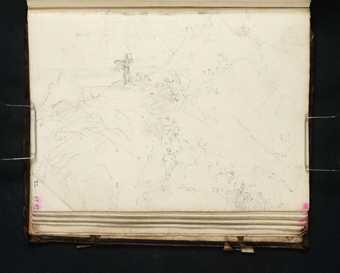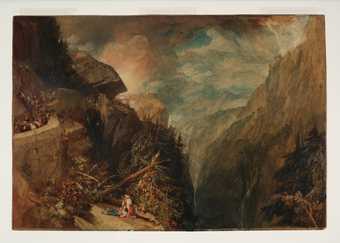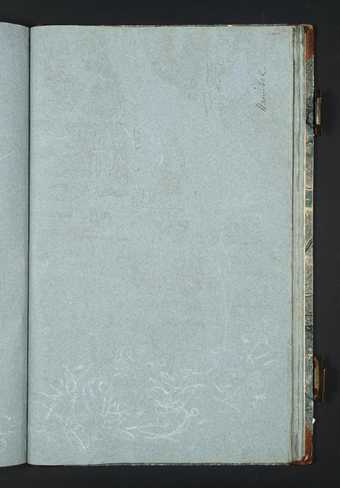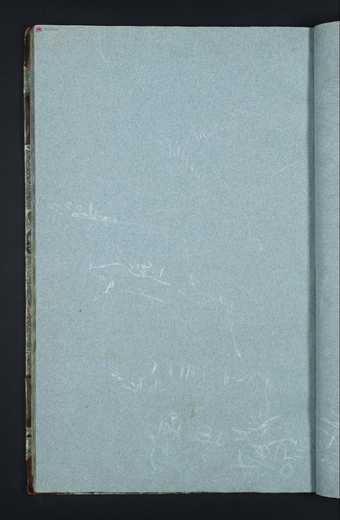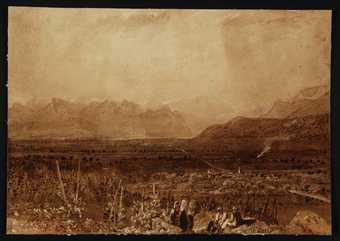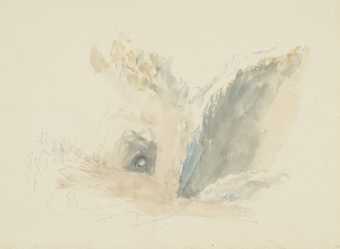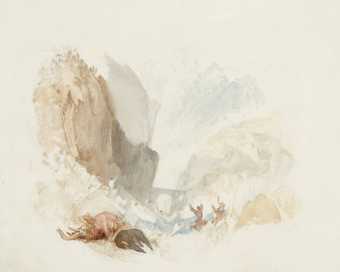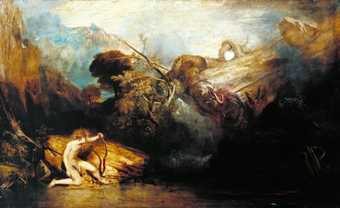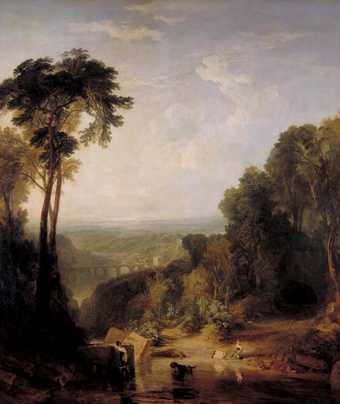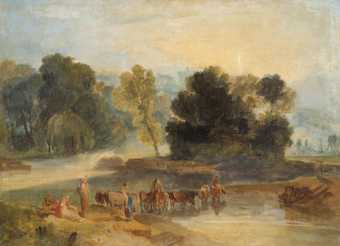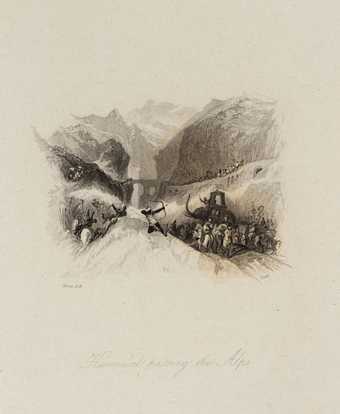
In Tate Britain
- Artist
- Joseph Mallord William Turner 1775–1851
- Medium
- Oil paint on canvas
- Dimensions
- Support: 1460 × 2375 mm
Frame (HxWxD): 1892x2800x200 mm - Collection
- Tate
- Acquisition
- Accepted by the nation as part of the Turner Bequest 1856
- Reference
- N00490
Display caption
Many of Turner’s peers saw the Napoleonic Wars as existential clashes between empires, comparing them to the ancient Trojan and Punic wars. France and Britain debated which was the modern Carthage or Rome. French artists portrayed Napoleon as a modern Hannibal, the Carthaginian general who led his army across the Alps into Italy in 218 BCE. Turner shows him as a tiny figure riding an elephant. He is overwhelmed by a whirling blizzard as mountain-dwellers attack his troops. Turner’s picture became prophetic later in 1812, when Napoleon was forced to retreat from Moscow by the Russian winter.
Gallery label, November 2022
Does this text contain inaccurate information or language that you feel we should improve or change? We would like to hear from you.
Catalogue entry
126. [N00490] Snow Storm: Hannibal and his Army crossing the Alps Exh. 1812
THE TATE GALLERY, LONDON (490)
Canvas, 57 1/2 × 93 1/2 (146 × 237·5)
Coll. Turner Bequest 1856 (6, ‘Hannibal crossing the Alps’ 7'9" × 4'9 1/2"); transferred to the Tate Gallery 1910.
Exh. R.A. 1812 (258); Tate Gallery 1931 (49); Tate Gallery 1959 (347); Paris 1972 (262, repr.); Lisbon 1973 (6, repr. in colour); R.A. 1974–5 (88, repr.); Leningrad and Moscow 1975–6 (7); Munich 1979–80 (220, repr.); Paris 1983–4 (28, repr. in colour); Birmingham 1984.
Lit. Farington Diary 10, 11, 13, 14 and 15 April 1812; Ruskin 1843 (1903–12, iii, p. 239); Leslie 1860, ii, p. 12; Thornbury 1862, i, pp. 170, 294; ii, pp. 87–8; H. C. Robinson, ed. Thomas Sadler, Diary, Reminiscences and Correspondence, 1869, i, p. 381; Thornbury 1877, pp. 122, 168, 239, 342, 430–31; Hamerton 1879, pp. 138, 197; Monkhouse 1879, pp. 66, 76; Eastlake 1895, i, p. 188; Bell 1901, pp. 92–3 no. 127; Armstrong 1902, pp. 85, 104, 109–11, 222; MacColl 1920, pp. 9–10; Whitley 1928, pp. 199–200; Falk 1938, pp. 72, 96; Davies 1946, p. 185; T.S.R. Boase, ‘English Artists of the Val d'Aosta’, Journal of the Warburg and Courtauld Institutes xix 1956, pp. 286–8, pl. 60d; Finberg 1961, pp. 187–90, 195, 276, 414, 474–5 no. 180; Herrmann 1963, pp. 19, 35, pl. 6; Kitson 1964, pp. 18, 73, repr. p. 32; Rothenstein and Butlin 1964, pp. 30–31, 76, pl. 49; Michael Kitson, ‘Snowstorm: Hannibal Crossing the Alps’, Painting of the Month August 1965, pp. 73–6, repr. in colour; Gowing 1966, p. 9, repr.; Lindsay 1966, pp. 41, 107, 117–22, 132–3, 136, 138–9, 236 n. 29; Lindsay 19662, pp. 47–9; Brill 1969, pp. 14–15, repr.; Gage 1969, pp. 145, 161, 228 n. 41, 262 n. 114; Reynolds 1969, pp. 86–8, 94, pl. 65; Holcomb 1970, pp. 25–7, pl. 13; Gaunt 1971, p. 5, colour pl. 11; Watson 1971, pp. 119–20, pl. 40; Kroeber 1974, pp. 328–34; Herrmann 1975, pp. 20–21, 23, 39, 54, 229, colour pl. 57; Russell and Wilton 1976, p. 17; Kroeber 1978, pp. 161–4; Storch 1978, pp. 199–201, pl. 52; Vaughan 1979, p. 471; Wilton 1979, pp. 94, 99, 153–6, 203, pl. 165; Gage 1980, pp. 53, 87–8; Matteson 1980, pp. 385–6, 390–6, pl. 1; Wilton 1980, pp. 36, 72–5, pl. xiii; Paulson 19822, pp. 150–1, pl. 98.
Turner's verses in the 1812 catalogue are described for the first time as coming from his ‘MS.P[oem?]. Fallacies of Hope’, the source of most of his later quotations though almost certainly never a complete entity. The verses echo lines 41–9 of Thomson's ‘Winter’:
‘Craft, treachery, and fraud—Salassian force,
Hung on the fainting rear! then Plunder seiz'd
The victor and the captive, —Saguntum's spoil,
Alike, became their prey; still the chief advanc'd,
Look'd on the sun with hope;—low, broad, and wan;
While the fierce archer of the downward year
Stains Italy's blanch'd barrier with storms.
In vain each pass, ensanguin'd deep with dead,
Or rocky fragments, wide destruction roll'd.
Still on Campania's fertile plains—he thought,
But the loud breeze sob'd, “Capua's joys beware!”’
Hannibal's crossing of the Alps in 218 B.C. and his skirmishes with local tribesmen were described by Livy (lxx, 33–4) and Polybius (iii, 51–3). Turner's use of the word ‘Salassian’ in his verses shows that he accepted the contemporary theory that Hannibal had passed through the Val d'Aosta, visited by Turner in 1802. Hannibal's crossing was a common source of Romantic and proto-Romantic inspiration. Matteson suggests that one of Turner's sources may have been Thomas Gray's list of imaginary paintings by artists of the past which included, as by Salvator Rosa, ‘Hannibal passing the Alps; the mountaineers rolling rocks upon his army; elephants tumbling down the precipices’ (Poems, 1775, p. 307). Mrs Radcliffe's The Mysteries of Udolpho, 1794, describes the scene later painted by Turner, who was probably also inspired by the lost oil painting by J.R. Cozens, which passed through the sale rooms in 1802. Cozens' painting, however, showed the later, more hopeful moment when Hannibal showed his troops the fertile plains of Italy. Here Turner not only shows the hazards of the crossing but hints at the enervating effect of Italian luxury: ‘“Capua's joys beware!”’ John Gage has suggested that Turner saw a parallel between the struggle of Rome and Carthage and that between England and Napoleonic France (see exhibition catalogue, Paris 1972, no. 262). On his visit to Paris in 1802 Turner had visited David's studio and seen his picture of Napoleon on the St Bernard Pass in which Napoleon was shown as the modern Hannibal (repr. Matteson, op. cit., pl. 12).
There is a sketch for the foreground figures inscribed ‘Hannibal’ in the ‘Calais Pier’ sketchbook (LXXXI-38, 39; repr. Matteson op. cit., pl. 6) which suggests that Turner was thinking of the subject at least eight or so years before the actual painting. More immediate stimuli may, as Matteson suggests, have been the arrival of a Tyrolese delegation in London late in 1809 to ask for help in their resistance against Napoleon, and Walter Fawkes's The Chronology of the History of Modern Europe, published in 1810, which treated of Napoleon. These could well have aroused the parallel in Turner's mind between Hannibal's failure and the hoped for eventual failure of Napoleon's enterprises. In addition The Artist's Repository had in 1808 appealed for treatments of the theme of Hannibal based on drawings made on the spot.
The association with Fawkes also adds substance to the well-known story that another source of inspiration for this picture was a storm seen at his patron Walter Fawkes' house, Farnley Hall in Yorkshire, in 1810. According to Fawkes' son, Hawkesworth, Turner even foresaw the use he would make of his sketch: ‘“There”, said he, “Hawkey; in two years you will see this again, and call it Hannibal crossing the Alps.”’
Farington, who was on the Hanging Committee of the R.A. in 1812, records Turner's concern over the hanging of this picture at Somerset House. On 10 April ‘Turner's large picture of “Hannibal crossing the Alps” was placed over the door of the new room (but in the great room) & it was thought was seen to great advantage. Mr. West came and concurred in this opinion with Smirke, Dance & myself. Calcott [sic] came and remarked that Turner had sd. That if this picture were not placed under the line He wd. rather have it back; Calcott also thought it wd. be better seen if under the line. He went away & we took the picture down & placed it opposite to the door of entrance the situation which Calcott mentioned. Here it appeared to the greatest advantage,—a scene of confusion and injuring the effect of the whole of that part of the arrangement. We therefore determined to replace it which was done.’
On the 11th, ‘In the course of the morning Calcott came & Dance with Smirke informed him that Turner's large picture had been tried under the line and the effect was very disadvantageous both to the picture & to the Exhibition. I did not meet Calcott... Whilst we were at dinner Turner came and took a little only having dined early. He asked me “What we had done with His pictures?”. I told him we had had much difficulty abt. His large picture “Hannibal crossing the Alps”. He went upstairs & staid a while and afterwards returned to us with an apparently assumed chearfulness but soon went away and took Howard out of the room, who soon came back & informed us that Turner objected to His picture being placed above the line. Howard assured Him it was seen there to better advantage, but He persisted in saying that if it were not to be placed below the line He would take it away; that as He saw us chearfully seated He would not now mention His intention to us, but would come on Monday morning [this was Saturday] to have the matter finally determined. Smirke & Dance were decided to abide by the arrangement the Committee had made, and to leave Him to act as He may please.’
On Monday 13 April ‘Turner came at noon and after some conversation with Smirke in which He expressed His determination to have His picture of “Hannibal crossing the Alps” placed below the line, or He would withdraw it, adding that [he] wished to have the joint determination of the Committee respecting it. Smirke told him in the presence of Dance & myself, that having heard what He had said on the subject it was a matter for our consideration. He then went away. I then proposed to place His picture at the head of the new room which was agreed to ... Calcott came before dinner. He talked with Smirke abt. the new situation of Turner's picture, sd. it was better placed than before, but did not say He approved it.’
The next day, Tuesday 14 April, after a Council meeting in the evening, 'Turner went upstairs & saw his large picture as it was placed in the new room. He appeared to be in good humour, but said He would not decide till tomorrow when he shd, see it by day-light.
On 15th April Farington ‘went to breakfast at the Academy. Turner came and approved of the situation of His large picture provided other members shd. have pictures near it.’
Turner's concern that the painting should hang relatively low so as to ensure the correct viewpoint had a paradoxical result for at least one viewer. C. R. Leslie, writing to his sister Miss Leslie on 12 May 1812, reported that he had been to the first day of the R.A. exhibition but that ‘the rooms were so crowded I could not enjoy it all ... There is a grand Landscape by Turner, representing a scene in the Alps in a snow storm, with Hannibal's army crossing; but as this picture is placed very low, I could not see it at the proper distance, owing to the crowd of people. Allston [the American painter Washington Allston, 1779–1843] says it is a wonderfully fine thing: he thinks Turner the greatest painter since the days of Claude.’
The picture was well received by the critics. For the Examiner on 7 June 1812, ‘This is a performance that classes Mr. Turner in the highest rank of landscape painters, for it possesses a considerable portion of that main excellence of the sister Arts, Invention ... This picture delights the imagination by the impressive agency of a few uncommon and sublime subjects in material nature, and of terror in its display of the effects of moral evil.’ The main body of the army is ‘represented agreeably to that principle of the sublime which arises from obscurity’ but ‘An aspect of terrible splendour is displayed in the shining of the sun... A terrible magnificence is also seen in the widely circular sweep of snow whirling high in the air ... In fine, the moral and physical elements are here in powerful unison blended by a most masterly hand, awakening emotions of awe and grandeur.’ The critic of the Repository of Arts, Literature, Commerce for 12 June was ‘almost led to describe it as the effect of magic, which this Prospero of the graphic arts can call into action, and give to airy nothing a substantial form ... All that is terrible and grand is personified in the mysterious effect of the picture; and we cannot but admire the genius displayed in this extraordinary work.’ According to the St. James's Chronicle for 23–6 May the ‘sun is painted with peculiar felicity, and the warm tinting from the great source of light struggling through the blackness of the storm, gives a fine relief to the subject, which is still further improved by the introduction of a corner of cloudless sky on the left.’
Other contemporary opinions include that of Henry Crabb Robinson, who wrote in his diary on 5 May 1812 that the picture ‘seemed to me the most marvellous landscape I had ever seen ... I shall never forget it’. Crabb Robinson also reports, on 15 May 1812, of Flax-man that ‘He spoke of Turner's landscape with great admiration, as the best painting in the Exhibition.’
Turner returned to the theme of Hannibal crossing the Alps in his illustrations to Rogers' Italy, published in 1830; see Mordechai Omer, exh. cat. Turner and the Poets, Marble Hill, Twickenham, University of East Anglia, Norwich, and Central Art Gallery, Wolverhampton April–August 1975, introduction, the engraving and two preliminary watercolours (CCLXXX-152 and 153) repr. figs. 3, and, in colour, 1 and 2.
Published in:
Martin Butlin and Evelyn Joll, The Paintings of J.M.W. Turner, revised ed., New Haven and London 1984
Explore
- history(5,776)
- actions: expressive(2,622)
-
- attacking(165)
- black(796)
- army(201)
- countries and continents(17,390)
-
- Italy, Valle d’Aosta(111)
- Alps(836)
- crime and punishment(436)
-
- rape(19)
You might like
-
Joseph Mallord William Turner Composition Study: An Army Climbing to the Crest of a Mountain
1798 -
Joseph Mallord William Turner The Battle of Fort Rock, Val d’Aouste, Piedmont, 1796
exhibited 1815 -
Joseph Mallord William Turner Study for a Picture of Hannibal Crossing the Alps
c.1799–1805 -
Joseph Mallord William Turner Study for a Picture of Hannibal Crossing the Alps
c.1799–1805 -
Joseph Mallord William Turner Chain of Alps from Grenoble to Chamberi
c.1808 -
Joseph Mallord William Turner Study for ‘Hannibal Passing the Alps’, for Rogers’s ‘Italy’
c.1826–7 -
Joseph Mallord William Turner Study for ‘Hannibal Passing the Alps’, for Rogers’s ‘Italy’
c.1826–7 -
Joseph Mallord William Turner Hannibal Passing the Alps, for Rogers’s ‘Italy’
c.1826–7 -
Joseph Mallord William Turner Study for ‘Hannibal Passing the Alps’, for Rogers’s ‘Italy’
c.1826–7 -
Joseph Mallord William Turner Inscription by Turner: Recollection of Verse Composed for the Painting ‘Snow-Storm: Hannibal and his Army Crossing the Alps’
1836 -
Joseph Mallord William Turner Apollo and Python
exhibited 1811 -
Joseph Mallord William Turner Crossing the Brook
exhibited 1815 -
Joseph Mallord William Turner Men with Horses Crossing a River
c.1806–7 -
Philip James De Loutherbourg An Avalanche in the Alps
1803 -
After Joseph Mallord William Turner Hannibal Passing the Alps
1830

